
Tadcaster is a market town and civil parish in North Yorkshire, England, 15 miles (24 km) north-east of Leeds and 10 miles (16 km) south-west of York. Its historical importance from Roman times onward was largely as the lowest road crossing-point on the River Wharfe until the construction of the A64 Tadcaster by-pass some 660 yards (600 m) to the south, in 1978. There are two rail crossings downstream of the town before the Wharfe joins the River Ouse near Cawood.

Stamford Bridge is a village and civil parish on the River Derwent in the East Riding of Yorkshire, England, approximately 5 miles (8 km) east of York and 22 miles (35 km) west of Driffield. The village sits astride an ancient ford on the River Derwent.
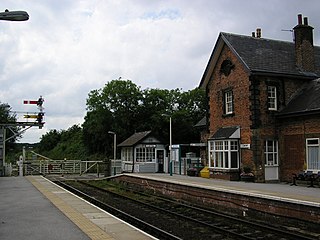
Cattal is a village and civil parish in the Borough of Harrogate district of North Yorkshire, England, about 6 miles (9.7 km) east of Knaresborough, and is located 12 miles (19 km) west of the city of York. Cattal is located on the River Nidd. Despite being a small village it is served by Cattal railway station on the Harrogate line ; the railway station generally provides an hourly service to the nearby cities of York and Leeds.

Farndon Bridge, also known as Holt Bridge, crosses the River Dee and the England-Wales border between the villages of Farndon, Cheshire, England and Holt, Wrexham, Wales. The bridge, which was built in the mid-14th century, is recorded in the National Heritage List for England and by Cadw as a designated Grade I listed building and scheduled monument. It is built from locally quarried red sandstone and had eight arches, of which five are over the river. On the Farndon side there is one flood arch and two flood arches are on the Holt side.

The River Irwell Railway Bridge was built for the Liverpool & Manchester Railway (L&MR), the world's first passenger railway which used only steam locomotives and operated as a scheduled service, near Water Street in Manchester, England. The stone railway bridge, built in 1830 by George Stephenson, was part of Liverpool Road railway station. The bridge was designated a Grade I listed building on 19 June 1988.
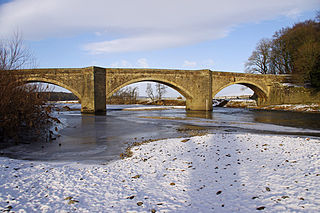
Loyn Bridge crosses the River Lune, carrying a minor road between the villages of Hornby and Gressingham in Lancashire, England. The present bridge replaces an older bridge, which is thought to have been constructed with timber decking between stone piers. There is evidence that the river was forded here before a bridge was built. The date of the building of the present bridge is unknown; it is considered to have been after 1591, when the previous bridge was described as being "in a dangerous condition". A date of 1684 has been suggested, but petitions regarding the bridge put before the Quarter Sessions between 1650 and 1750 make no mention of a new bridge between these dates. The bridge was paid for by the County of Lancashire, and later the responsibility for maintenance and repairs was transferred to the Lonsdale Hundred.
Haselbury Bridge is a stone built bridge dating from the 14th century in Haselbury Plucknett in the English county of Somerset. It is a scheduled monument and Grade II* listed building.

Tadcaster Bridge or Wharfe Bridge spans the River Wharfe in Tadcaster, North Yorkshire, England. The road bridge is believed to date from around 1700. It is the main route connecting the two sides of the town and one of two road crossings in the town, the other being the bridge for the A64 bypass. Tadcaster Bridge partially collapsed on 29 December 2015 after flooding that followed Storm Eva, and reopened on 3 February 2017.
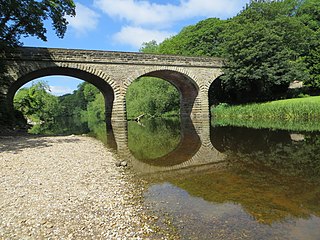
Linton Bridge carries the minor road that links Collingham and Linton over the River Wharfe near Wetherby in West Yorkshire, England.

Knaresborough Viaduct is a viaduct in the North Yorkshire town of Knaresborough, England. The viaduct carries the Harrogate line over the River Nidd in the town. The viaduct was supposed to have opened in 1848, but the first construction collapsed into the river very near to completion, which necessitated a new viaduct and delayed the opening of the line through Knaresborough by three years.

Monks Bridge is a road bridge across the River Dove between Stretton, Staffordshire, and Egginton, Derbyshire. A bridge has existed here since the early 13th century, though much of the current structure dates to the 15th century. It formerly carried traffic on what is now the A38 road but a replacement structure was built to the north in 1926. It was formerly used as a slip road but is now out of use to vehicular traffic.
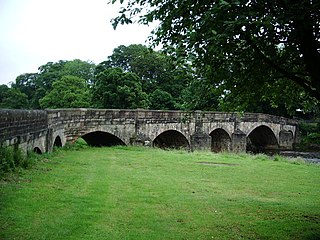
Edisford Bridge is a toll-free, nine-span bridge over the River Ribble near Clitheroe, Lancashire, England. A Grade II listed structure and a Scheduled monument, located about a mile WSW of the centre of town, it crosses the river to the civil parish of Great Mitton. The bridge carries the two-lane traffic of the B6243 Edisford Road.
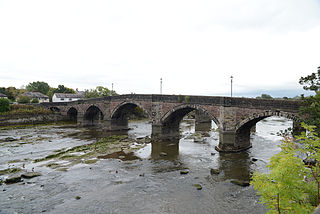
Penwortham Old Bridge is a toll-free, five-span bridge over the River Ribble at Preston, Lancashire, England. A Grade II listed structure and a scheduled monument, located about a mile southwest of the centre of the city, it crosses the river to Penwortham. Today the bridge no longer carries motorised traffic.

Sutton Bridge is a historic bridge in Yorkshire, in England.

Stamford Bridge is a historic bridge, in the village of Stamford Bridge, in the East Riding of Yorkshire in England.

Hampton in Arden packhorse bridge crosses the River Blythe near Hampton in Arden in the West Midlands of England, between Birmingham and Coventry. Dating from the 15th century, it is the only bridge of its kind in the area now covered by the West Midlands, and is a grade II* listed building and a scheduled monument.

Ferry Bridge is a historic bridge, connecting Ferrybridge in West Yorkshire with Brotherton in North Yorkshire, in England.

Kilgram Bridge is a crossing point across the River Ure in North Yorkshire, England. The bridge, which has six arches, is thought to date back to the 12th century, and it is thought that it is built on the old Roman ford crossing point of the river. Kilgram bridge is traditionally associated as being at the eastern and lower end of Wensleydale and is now a scheduled monument.

Burnsall Bridge is a historic bridge across the River Wharfe in North Yorkshire, in England.
Cattal is a civil parish in the former Harrogate district of North Yorkshire, England. It contains three listed buildings that are recorded in the National Heritage List for England. All the listed buildings are designated at Grade II, the lowest of the three grades, which is applied to "buildings of national importance and special interest". The parish contains the village of Cattal and the surrounding area, and the listed buildings consist of a road bridge and two houses.



















